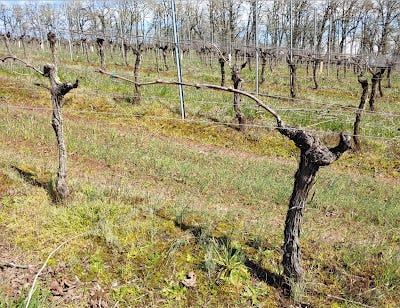Amalie Robert Estate: Thank you & Happy Easter!
Hello and Welcome, This is us wishing you a Happy Easter! A FLOG communication from Dena and Ernie at @AmalieRobertEstate. We would like to extend a very personal Thank You to everyone who has taken the time to reach out to us. Yes, we are still here and both physically healthy; the mental health is an evolving work in progress. We appreciate your thoughts and efforts to connect with us. Please feel free to drop us a line anytime or tweet us @AmalieRobert. You can also share an image. A picture is still worth a thousand words.

If you want to see a real Cluster Pluck, check out our harvest video:
http://www.vinestories.com/video.php?video=117974400
Check this space after Easter, and Ernie will share his braised Rabbiduck with white beans recipe. Very Pinot friendly, Meunier and Noir. And if you need some wine (preserved wine berries) for your Easter Celebratory purposes, please visit Amalie Robert Direct. The winery is open for pickups by appointment all week and we are shipping nationwide. If you are looking for a more traditional duck experience, you can always check out Maple Leaf Farms here: http://www.mapleleaffarms.com/
Everyone’s perspective is influenced by national and local circumstances. From what we see it looks like we could be turning a corner. What awaits us around that corner is yet to be seen. But let’s have a look anyway. There are a couple of Coronavirus survivors that can give us all inspiration. Both of these men served our country in World War II, and now it would seem they have survived what could be considered a third War on our World.
William “Bill” Lapschies, who just celebrated his 104th birthday, and Bill Kelly, who is 95 years young, both live in Oregon and tested positive for the Coronavirus in early March. They hunkered down and did what needed to be done - today, just as they did back in the day. The month of April finds them both recovered. There are several wonderful stories written about both men that you can find online - if you have the time…
As the month of April begins to unfold, the vines will start waking up from their 6 month hiatus to find they are now subject to social distancing. Not really a big deal for them, as they have been 4 feet apart since they were planted back at the turn of the century.


The barrels however, well, that is a different matter. Their bung holes are only about 3 feet apart. In response, we have instituted a more frequent inspection schedule to ensure all bung holes are properly sealed with a tight-fitting bung. Chaste, we remain.
Just so you know, vines can get viruses, too. Mostly they are infected by some type of insect that is a carrier (or vector) for a virus. (If you think mosquitos and malaria, you are on the right mental track.) The most recent example was a bacterium called Pierce’s Disease that devastated the Temecula winegrowing region in California. The vector that spread the bacterium from vine to vine was an insect called the glassy-winged sharpshooter.
The vineyards were decimated, and the fledgling wine industry was devastated. That was the 1880’s. Fast forward to the 1990’s and Temecula vineyards had been replanted, but the bacterium and the glassy-winged sharpshooter were still there, just lying in wait. Once again devastation and financial ruin followed. This guy Peirce had some disease.
So, logically, as long as the Coronavirus has at least one host, going forward we can expect to be on guard for quite some time. And while we are viticulturalists and not virologists, we can expect slight mutations of the Coronavirus to keep us up on our (lip) sanitizer regime. We know this because Dena has summer allergies and slight mutations to the drug manufacturers’ formulas maintain their patent protections “ad infinitum”.
And vines need “vine yard” workers. Sure, Ernie has 3 tractors that he can deploy at a moment’s notice (assuming they will start), but most of the ultra-premium wine grown in the Willamette Valley needs hand labor. @AmalieRobertEstate if we are lucky and Mother nature smiles upon us, we need about 7 minutes of hand labor per plant to get us ready for harvest.
Speaking of harvest, there are quite a few new webinars now available to watch ranging from sipping wine to who knows what all. If you want to see a real Cluster Pluck, check out our harvest video: http://www.vinestories.com/video.php?video=117974400
Fortunately, during this “Stay Home, Stay Safe” period the vines are still dormant and do not require any attention. May is the month where we need vineyard workers to do some seriously intense canopy management, by hand. We will see what the labor pool looks like around Mother’s Day.
In the interest of your health, and those around you, Ernie would like to share his Super Antioxidant Smoothie recipe. And yes, you can put a shot of distilled spirit in the blend, right at the end. You will want a blender or “Super Bass-o-Matic 76” (especially if you try this “by hand” the first time), 2 ripe bananas, one cup of nonfat yogurt, a dozen strawberries, ½ cup of apple juice, ½ cup of blueberries and you can throw in a few almonds or walnuts if you are into that sort of thing. Add the liquids followed by the solids and activate your Super Bass-o-Matic 76! It’s just that simple!


If you are unfamiliar with how to operate the Super Bass-o-Matic 76, you can click on the captions below these images to view a brief YouTube tutorial hosted by “Not Ready for Primetime Player” Dan Aykroyd, circa April 1976.
You may be reading this and speaking to your monitor as if Ernie can hear you, “Hey Ernie, there are no fresh blueberries or strawberries at my grocery store.” Yes, he is nodding and smiling back at you. If farm labor supply becomes tight, you can expect more of these outages. Frozen berries may be the next big thing after toilet paper. Gotta see a man about a freezer…
Living here in rural utopia, we encounter those sorts of outages from time to time. Sometimes when we go to the store, we buy things that we don’t really need. We do that because they are out of the things that we do really need. And we would like to continue our evening meal ritual.
So, let’s look at how you can have your Super Antioxidant, High Octane Smoothie without the comfort and convenience of fresh berries. Back in the old days, the summer’s bounty was preserved by drying fruits and vegetables, and smoking or jerking a variety of proteins.
While not that common for most of us today, you may once again, someday, be able to dine at the Herbfarm in Woodinville Washingtonfor a modern implementation of the old days. Tweet Ron @Herbguy.
Or Fitts Seafoods in Salem, Oregon will ship you some fresh salmon that you can prepare, smoke, freeze, can or jerk. Tweet Rod @Fittscfood.
Back to your Smoothie. As humans advanced along their culinary journey, technology answered the call in the form of ice and iceboxes. All manner of foodstuffs could be put into an icebox containing ice. The foods would nearly freeze, thereby prolonging their “use by date” and denying the spoilage organisms and bacterium that most certainly awaited.
Canned goods and home canning were invented shortly thereafter and that is how we came to know botulism. It would be several decades until a commercially viable product would be developed from this deadly bacterium. And then to sell this product, Botox parties were invented!
Let’s stick with the evolutionary period that gave us iceboxes. Getting things cold to preserve them is a relatively lo-tech invention that is pretty easy to implement. Consider the last time you ate melted ice cream or drank warm beer. Refrigeration is not that complicated. You are perfectly within your lane to add frozen berries to create your Super Antioxidant, High Octane, Bass-o-Matic 76 Smoothie. And if you don’t finish it all, you can put it in the icebox for later! Note: With a slight modification of ingredients, you can make lime smoothies, aka Margaritas. This is an exercise left to the reader, and may add a little zip to your morning Zoom meeting.
And that brings us to the preservation of wine berries for future enjoyment. Unless you are drinking Beaujolais Nouveau, those tons upon tons of wine berries are not going to last very long if you do not find a way to preserve them. The technologies discussed so far including drying, jerking, canning, smoking (ask the California wineries about this one) and cold storage are not the right solution for the preservation of wine berries.

Portfolio of preserved wine berries showing the breadth and depth of Amalie Robert Estate
The need to preserve wine berries is at the root of modern day winemaking. It was discovered that allowing the wine berries to ferment would create alcohol that could kill any pathogen in the resulting wine. Humans caught a break there, as we were not all that smart way back when. Hemlock anyone? The fermented wine berries were then transferred into vessels that would slow the rate of spoilage until the wine could be consumed. Some vessels were good for a few days, others for a few months. Some vessels were simply not good at all. Add in the geo-political factors, and you end up with Madeira.
In modern times it is not uncommon for humans to gather in small groups to inject botulism toxin into their dermis and consume preserved wine berries while doing so. The next big thing on the horizon seems to be repurposing distilled spirits into hand sanitizers. And from there, no one knows where we go.
But we can supply you all of the Estate grown preserved wine berries you could ask for at Amalie Robert Direct. And still, a free cork in every bottle!
Kindest Regards,
Dena & Ernie



